Microwave-Driven Electrodeless Ultraviolet Lamp Based on Coaxial Slot Radiator
Abstract
1. Introduction
2. Methodology
2.1. Geometry
2.2. Plasma Parameters
2.3. Input Parameters
2.4. Boundary Conditions
3. Results and Discussion
3.1. Dimension Optimization
3.2. Sensitivity Analysis
3.3. Experimental Verification and UV Light Power Measurement
4. Conclusions
Author Contributions
Funding
Institutional Review Board Statement
Informed Consent Statement
Data Availability Statement
Conflicts of Interest
References
- Fu, J.; Xu, Z.; Li, Q.-S.; Chen, S.; An, S.-Q.; Zeng, Q.-F.; Zhu, H.-L. Treatment of simulated wastewater containing Reactive Red 195 by zero-valent iron/activated carbon combined with microwave discharge electrodeless lamp/sodium hypochlorite. J. Environ. Sci. 2010, 22, 512–518. [Google Scholar] [CrossRef]
- Zhang, Y.; Zhang, G.; Wang, P.; Wang, Q. Disinfection of municipal secondary effluents with microwave-induced electrodeless ultraviolet irradiation for water reuse. J. Chem. Technol. Biotechnol. 2017, 92, 1017–1025. [Google Scholar] [CrossRef]
- Tsuchida, A.; Oshimo, K.; Horikoshi, S. Microwave Discharge Electrodeless Lamps (MDELs). Part XI. Photolytic, Chemical Oxidation, and Photocatalytic Treatment of Aqueous Urea Solution with a Novel MDEL Photoreactor. J. Oleo Sci. 2018, 67, 917–924. [Google Scholar] [CrossRef] [PubMed]
- Cheng, G.; Lin, J.; Lu, J.; Zhao, X.; Cai, Z.; Fu, J. Advanced Treatment of Pesticide-Containing Wastewater Using Fenton Reagent Enhanced by Microwave Electrodeless Ultraviolet. BioMed Res. Int. 2015, 2015, 205903. [Google Scholar] [CrossRef][Green Version]
- Wen, Z.J.; Wang, A.M.; Zhang, Y.Y.; Ren, S.Y.; Tian, X.J.; Li, J.Y. Mineralization of cefoperazone in acid medium by the microwave discharge electrodeless lamp irradiated photoelectro-Fenton using a RuO2/Ti or boron-doped diamond anode. J. Hazard. Mater. 2019, 374, 186–194. [Google Scholar] [CrossRef]
- Oliveira, J.S.; Picoloto, R.; Bizzi, C.; Mello, P.; Barin, J.S.; Flores, E.M. Microwave-assisted ultraviolet digestion of petroleum coke for the simultaneous determination of nickel, vanadium and sulfur by ICP-OES. Talanta 2015, 144, 1052–1058. [Google Scholar] [CrossRef]
- Xia, L.Y.; Gu, D.H.; Tan, J.; Dong, W.B.; Hou, H.Q. Photolysis of low concentration H2S under UV/VUV irradiation emitted from microwave discharge electrodeless lamps. Chemosphere 2008, 71, 1774–1780. [Google Scholar] [CrossRef]
- Zeng, Q.F.; Fu, J.; Zhou, Y.; Shi, Y.T.; Zhu, H.L. Photooxidation Degradation of Reactive Brilliant Red K-2BP in Aqueous Solution by Ultraviolet Radiation/Sodium Hypochlorite. Clean Soil Air Water 2009, 37, 574–580. [Google Scholar] [CrossRef]
- Zhang, X.W.; Wang, Y.Z.; Li, G.T.; Qu, J.H. Oxidative decomposition of azo dye CI Acid Orange 7 (AO7) under microwave electrodeless lamp irradiation in the presence of H2O2. J. Hazard. Mater. 2006, 134, 183–189. [Google Scholar] [CrossRef]
- Lee, D.-J.; Park, Y.-K.; Kim, S.-J.; Lee, H.; Jung, S.-C. Photo-catalytic destruction of ethylene using microwave discharge electrodeless lamp. Korean J. Chem. Eng. 2015, 32, 1188–1193. [Google Scholar] [CrossRef]
- Laroussi, M.; Akan, T. Arc-free atmospheric pressure cold plasma jets: A review. Plasma Processes Polym. 2007, 4, 777–788. [Google Scholar] [CrossRef]
- Tatarova, E.; Bundaleska, N.; Sarrette, J.P.; Ferreira, C.M. Plasmas for environmental issues: From hydrogen production to 2D materials assembly. Plasma Sources Sci. Technol. 2014, 23, 3002. [Google Scholar] [CrossRef]
- Zhang, X.; Li, G.; Wang, Y. Microwave assisted photocatalytic degradation of high concentration azo dye Reactive Brilliant Red X-3B with microwave electrodeless lamp as light source. Dye. Pigment. 2007, 74, 536–544. [Google Scholar] [CrossRef]
- Ferrari, C.; Longo, I.; Socci, L.; Cavagnaro, M. Coaxially driven microwave electrodeless UV lamp. J. Electromagn. Waves Appl. 2014, 28, 669–684. [Google Scholar] [CrossRef]
- Singh, S.; Mishra, S.; Pradhan, R.; Vivek, K. Development of a microwave-assisted UV sterilization system for milk. Acta Aliment. 2019, 48, 9–17. [Google Scholar] [CrossRef]
- Horikoshi, S.; Tsuchida, A.; Serpone, N. Microwave discharge electrodeless lamps (MDELs). Part IX. A novel MDEL photoreactor for the photolytic and chemical oxidation treatment of contaminated wastewaters. Photochem. Photobiol. Sci. 2015, 14, 2187–2194. [Google Scholar] [CrossRef]
- Remya, N.; Swain, A. Soft drink industry wastewater treatment in microwave photocatalytic system—Exploration of removal efficiency and degradation mechanism. Sep. Purif. Technol. 2019, 210, 600–607. [Google Scholar] [CrossRef]
- Yintao, S.; Dongsheng, X.; Xuesen, W.; Qingfu, Z. Performance test of a microwave electrodeless lamp. In Proceedings of the 2011 International Symposium on Water Resource and Environmental Protection, Xi’an, China, 20–22 May 2011. [Google Scholar]
- Chen, X.; Yang, H.L.; Fei, P.; Xue, X.B.; Zhang, S.K.; Ge, J. The high frequency electrodeless mercury isotope lamp. In Proceedings of the Joint Conference of the IEEE International Frequency Control Symposium (IEEE IFCS) and IEEE International Symposium on Applications of Ferroelectrics (IEEE IFAS), Keystone, CO, USA, 19–23 July 2020. [Google Scholar]
- Horikoshi, S.; Kajitani, M.; Horikoshi, N.; Dillert, R.; Bahnemann, D.W. Use of microwave discharge electrodeless lamps (MDEL)—II. Photodegradation of acetaldehyde over TiO2 pellets. J. Photochem. Photobiol. A Chem. 2008, 193, 284–287. [Google Scholar] [CrossRef]
- Hong, J.; Sun, C.; Yang, S.G.; Liu, Y.Z. Photocatalytic degradation of methylene blue in TiO2 aqueous suspensions using microwave powered electrodeless discharge lamps. J. Hazard. Mater. 2006, 133, 162–166. [Google Scholar] [CrossRef]
- Horikoshi, S.; Kajitani, M.; Sato, S.; Serpone, N. A novel environmental risk-free microwave discharge electrodeless lamp (MDEL) in advanced oxidation processes—Degradation of the 2,4-D herbicide. J. Photochem. Photobiol. A-Chem. 2007, 189, 355–363. [Google Scholar] [CrossRef]
- Oberreuther, T.; Wolff, C.; Behr, A. Volumetric plasma chemistry with carbon dioxide in an atmospheric pressure plasma using a technical scale reactor. Trans. Plasma Sci. 2003, 31, 74–78. [Google Scholar] [CrossRef]
- Zhong, N.Y.; Zhu, H.C.; Yang, F.M.; Hong, T.; Yang, Y.; Huang, K.M. A new structure of microwave-driven UVlamp. Int. J. RF Microw. Comput. Aided Eng. 2021, 31, 12. [Google Scholar] [CrossRef]
- Wu, Y.; Xie, T.; Xiao, W.; Zhang, W.C.; Ma, W.Q.; Zhu, H.C.; Yang, Y.; Huang, K.M. A novel microwave combined ultraviolet radiator based on slotted coaxial line for epoxy resin curing. AIP Adv. 2018, 8, 11. [Google Scholar] [CrossRef]
- KZhuge, T.X. A Dielectric Resonant Cavity for Microwave Plasma Lamps. Patent CN103779177A; Sichuan, China, 7 May 2014. [Google Scholar]
- Kando, M.; Fukaya, T.; Ohishi, Y.; Mizojiri, T.; Morimoto, Y.; Shido, M.; Serita, T. Application of an antenna excited high pressure microwave discharge to compact discharge lamps. J. Phys. D Appl. Phys. 2008, 41, 4026. [Google Scholar] [CrossRef]
- Hansen, R.C. Phased Array Antennas; Wiley: New York, NY, USA, 1998; pp. 1–5. [Google Scholar]
- Zhao, H.C.; Xu, R.R.; Wu, W. Broadband waveguide slot array for SAR. Electron. Lett. 2011, 47, 76. [Google Scholar] [CrossRef]
- Wang, W.; Zhong, S.-S.; Zhang, Y.-M.; Liang, X.-L. A broadband slotted ridge waveguide antenna array. Trans. Antennas Propag. 2006, 54, 2416–2420. [Google Scholar] [CrossRef]
- Shin, D.H.; Eom, H.J. Radiation from narrow circumferential slots on a conducting circular cylinder. Trans. Antennas Propag. 2005, 53, 2081–2088. [Google Scholar] [CrossRef]
- Ho, C.; Shumaker, P.; Fan, L.; Smith, K.; Liao, J. Printed cylindrical slot antenna for GPS commercial applications. Electron. Lett. 1996, 32, 151–152. [Google Scholar] [CrossRef]
- Yancy, N.; Mandal, M.K.; Shaw, R. Coaxial Periodic Leaky Wave Antenna with Narrow Beamwidth and Improved Broadside Gain. In Proceedings of the IEEE Indian Conference on Antennas and Propogation (InCAP), Hyderabad, India, 16–19 December 2018. [Google Scholar]
- Yuan, Z.C.; Shi, J.M. Collisional, nonuniform plasma sphere scattering calculation by FDTD employing a drude model. Int. J. Infrared Millim. Waves 2007, 28, 987–992. [Google Scholar]
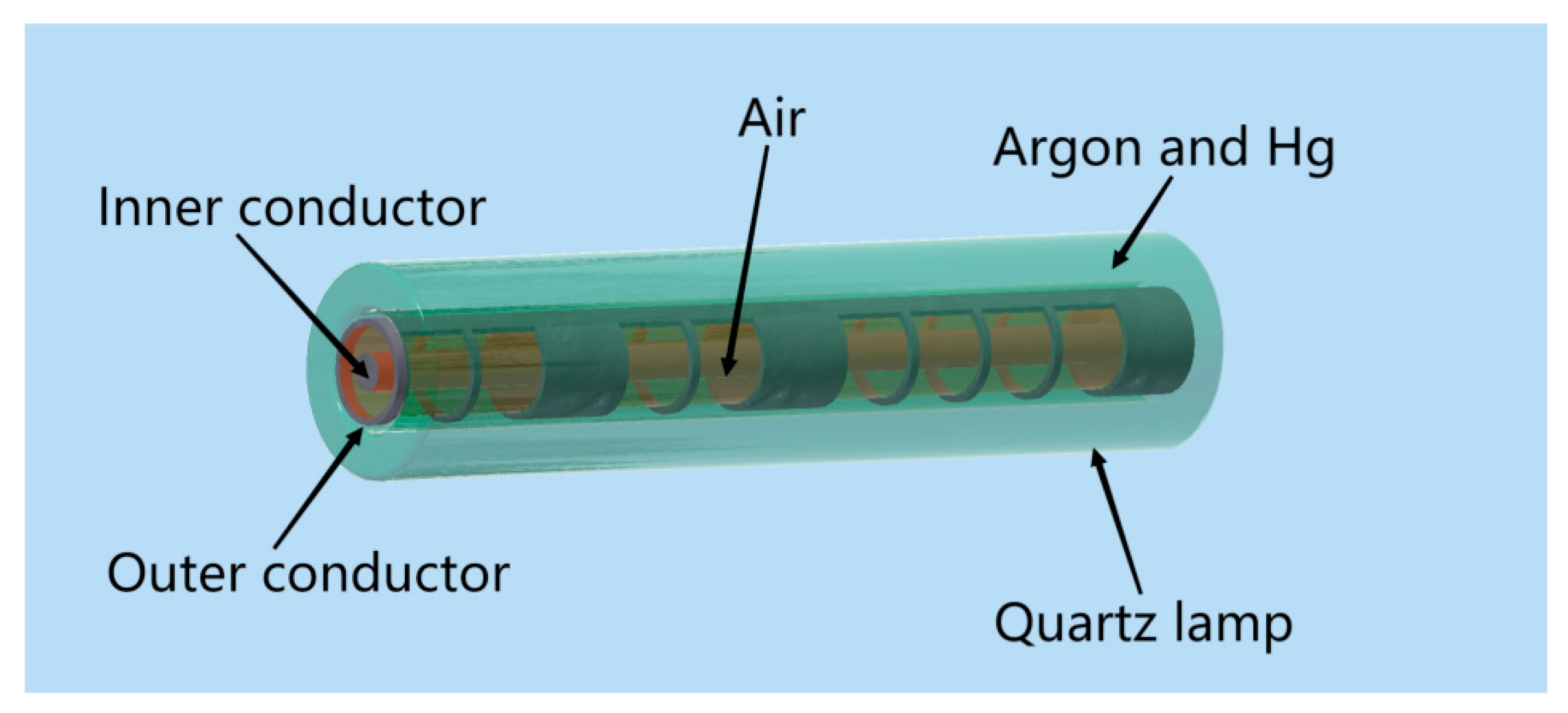
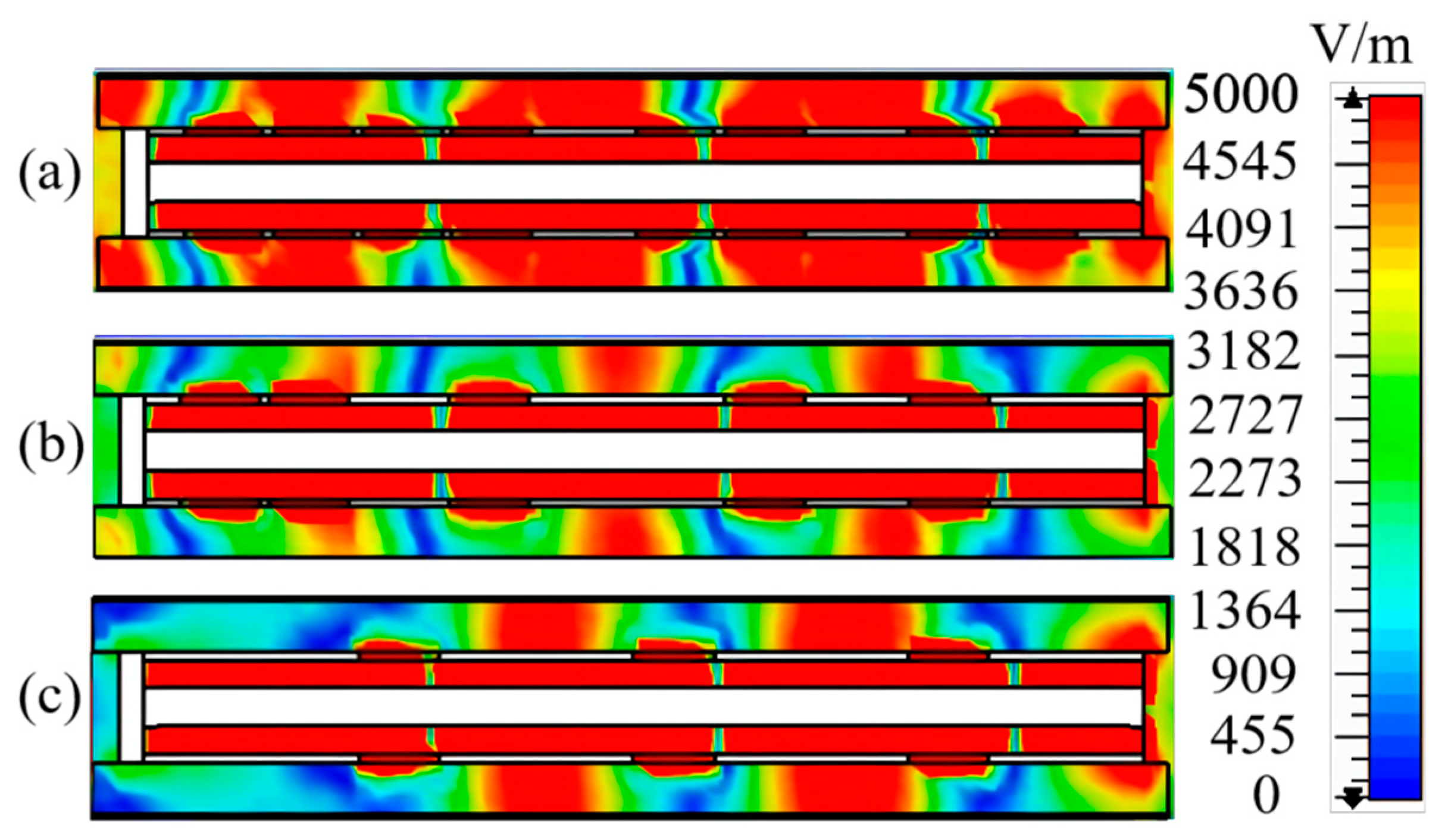
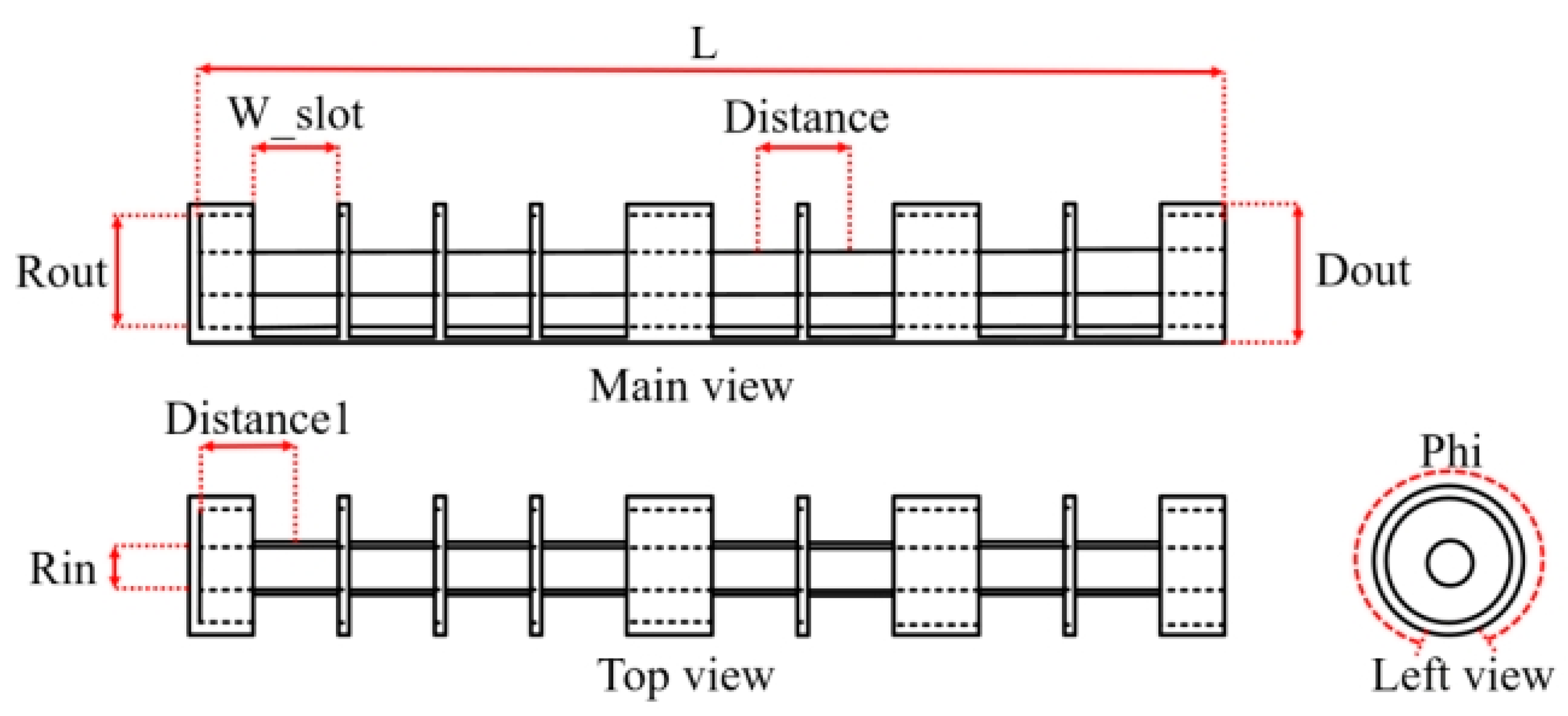

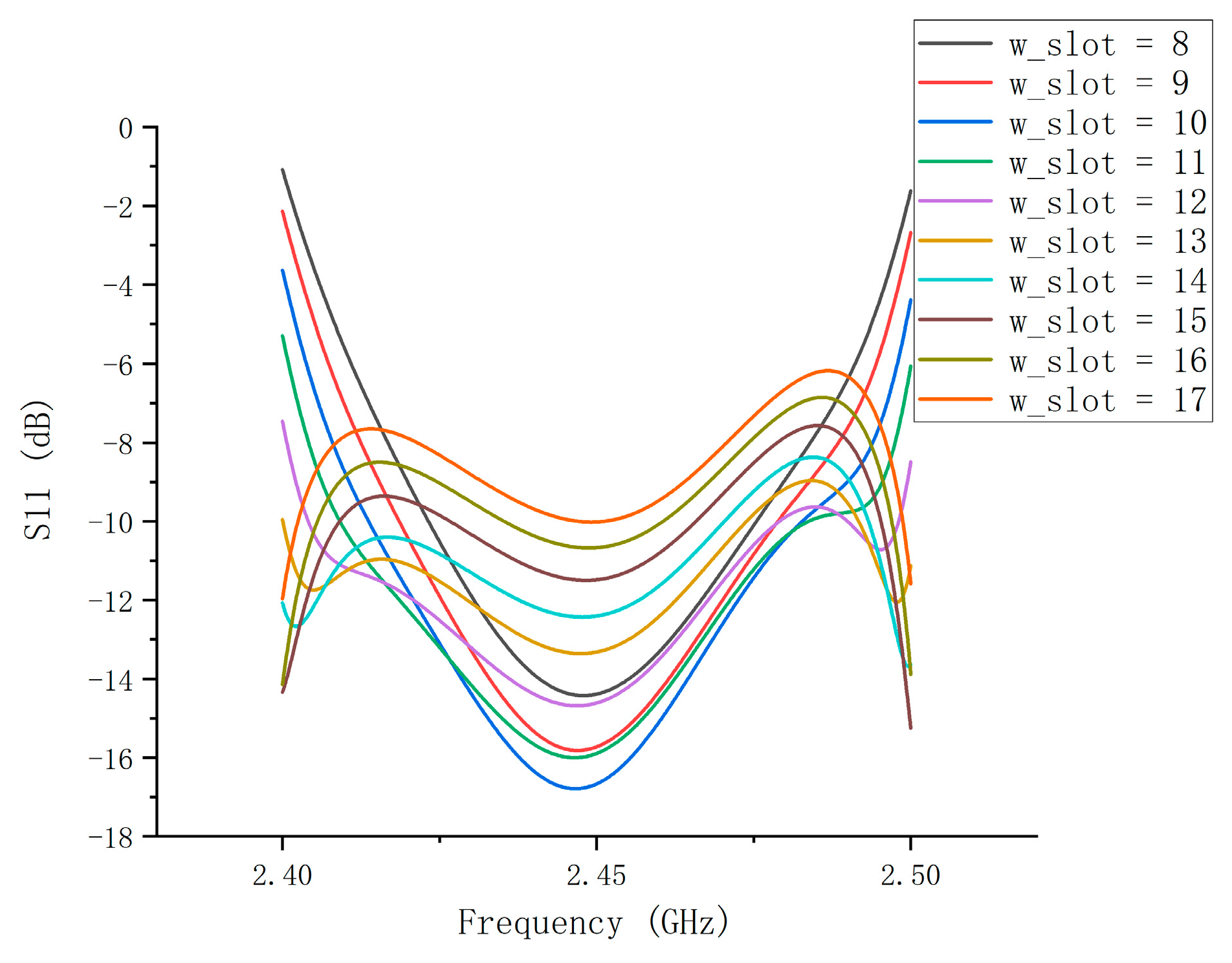
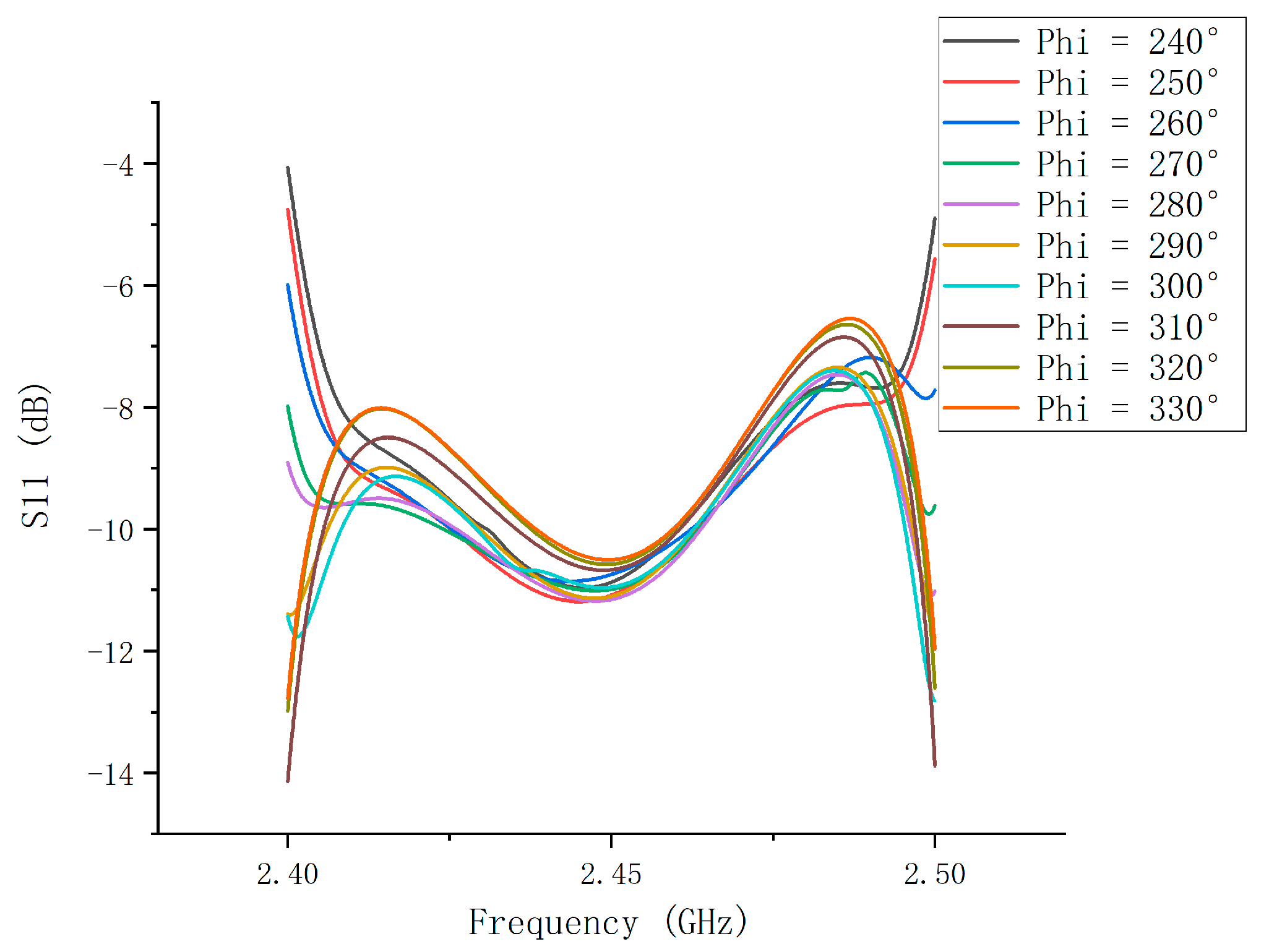
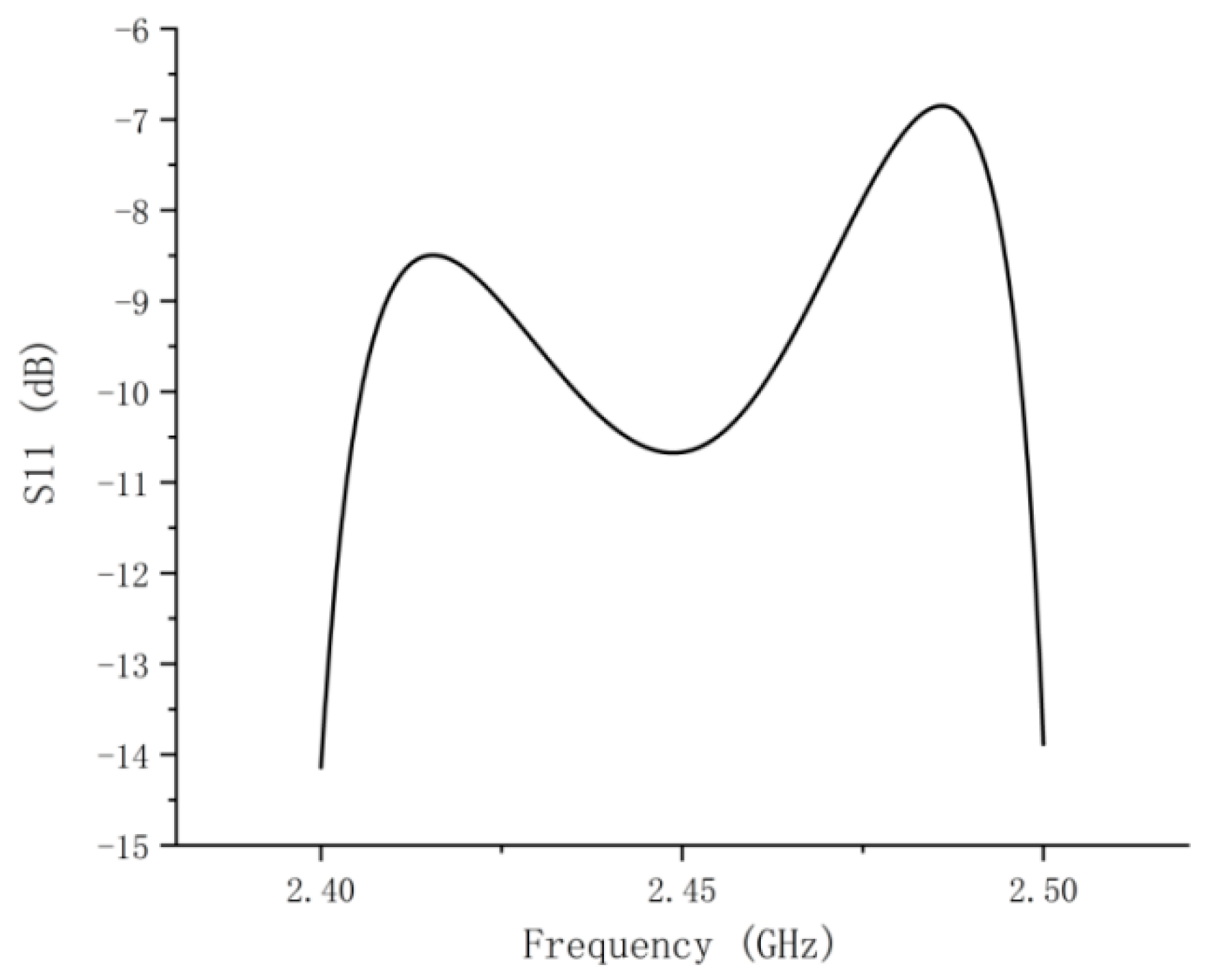
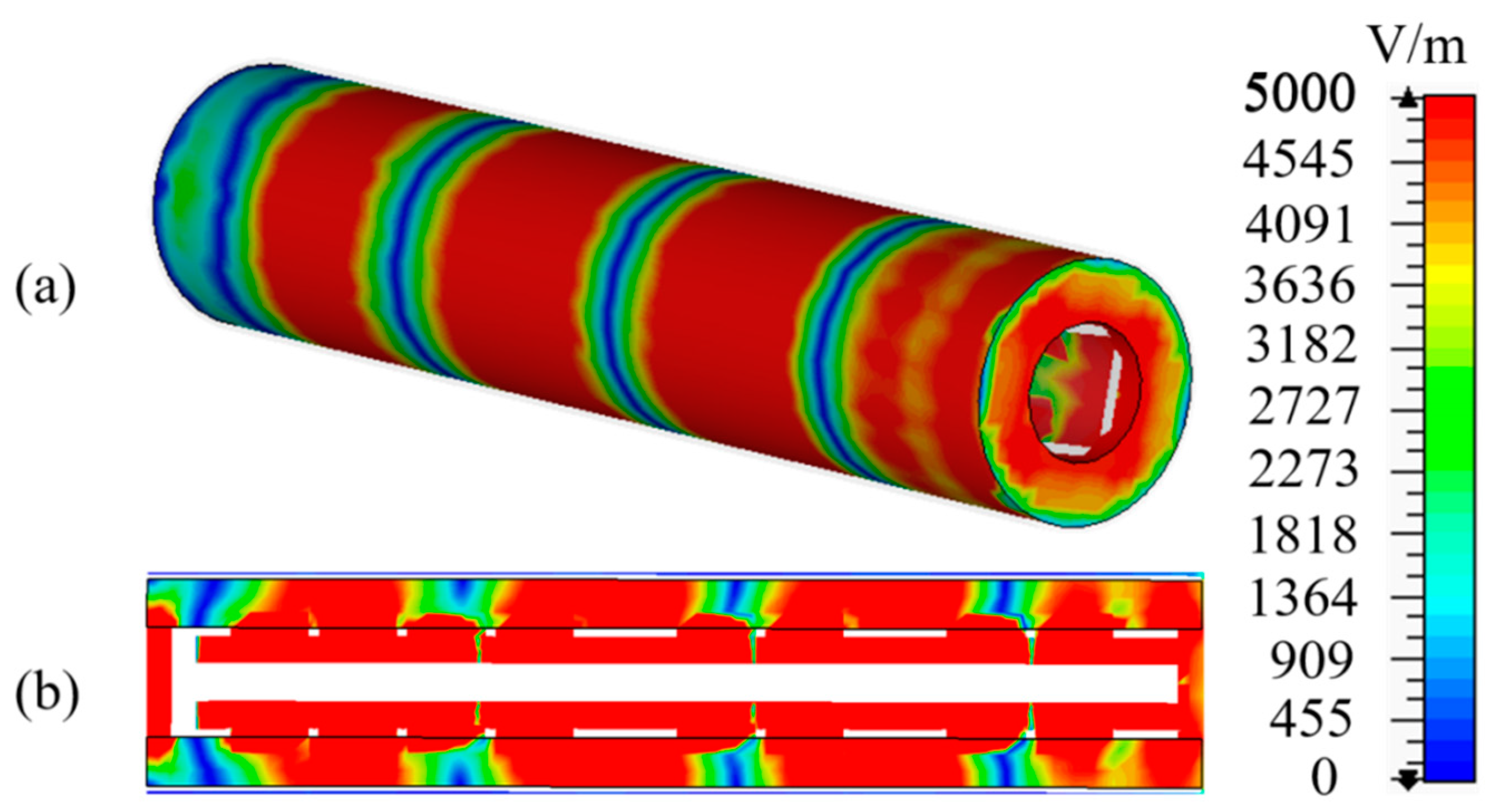
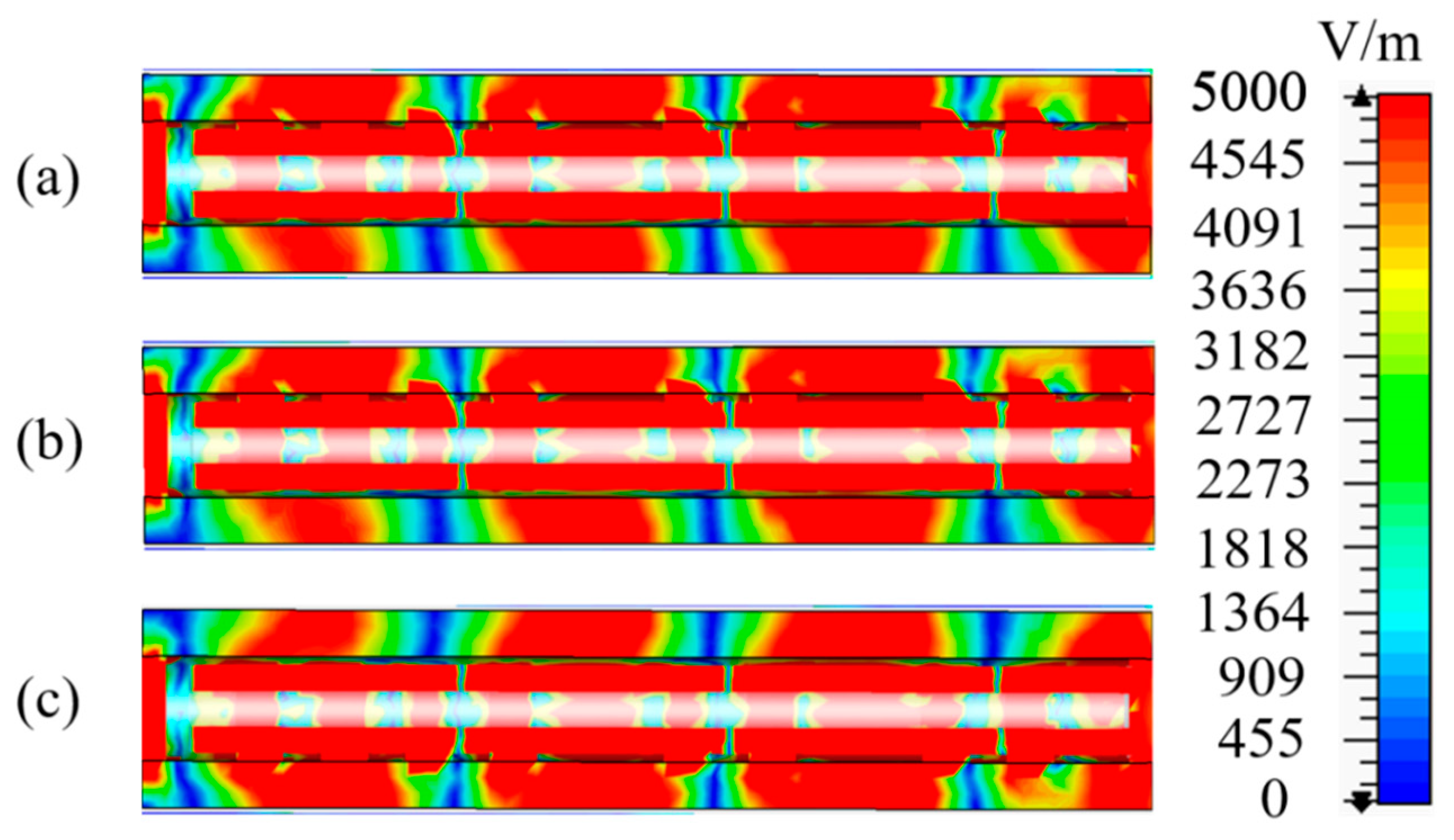
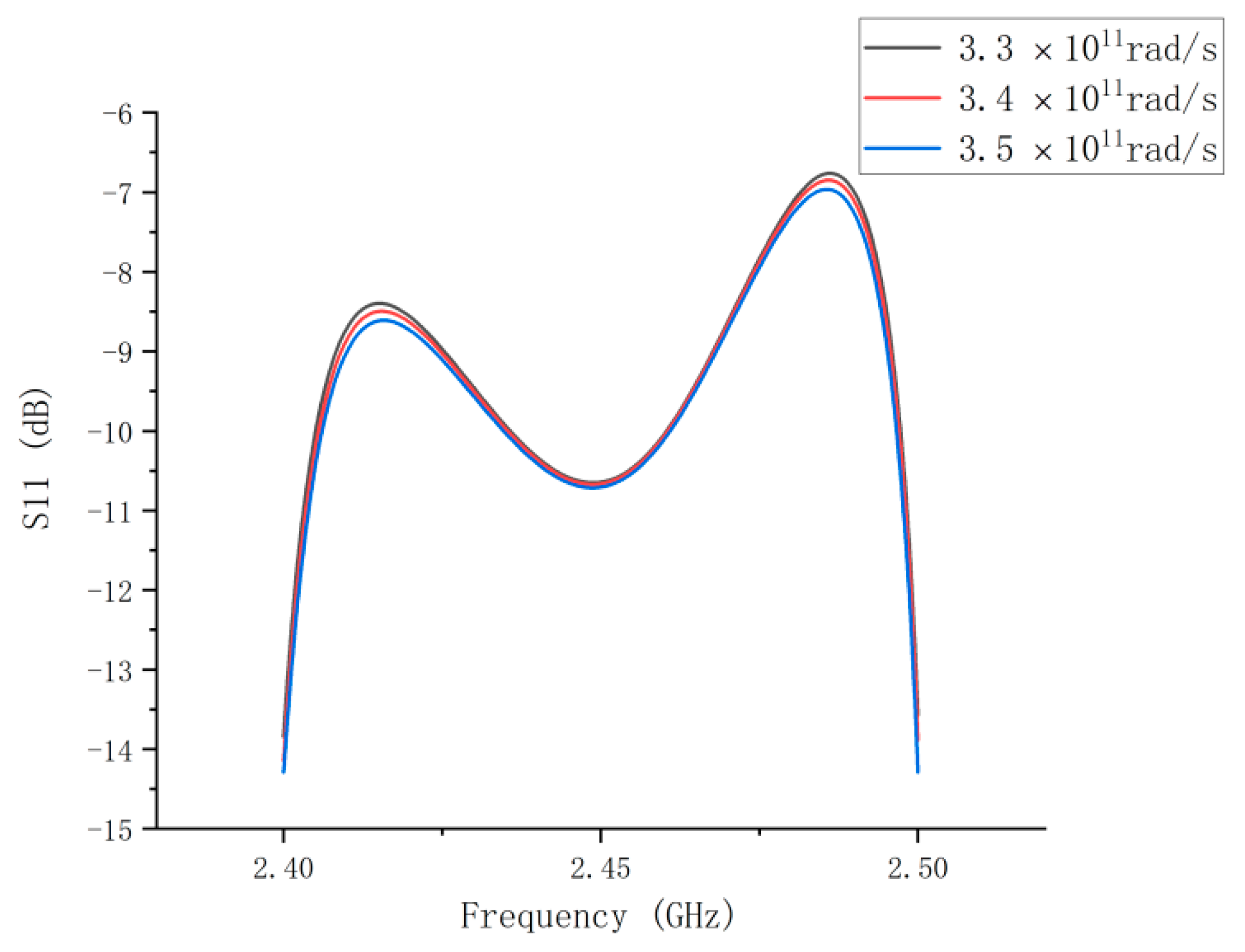

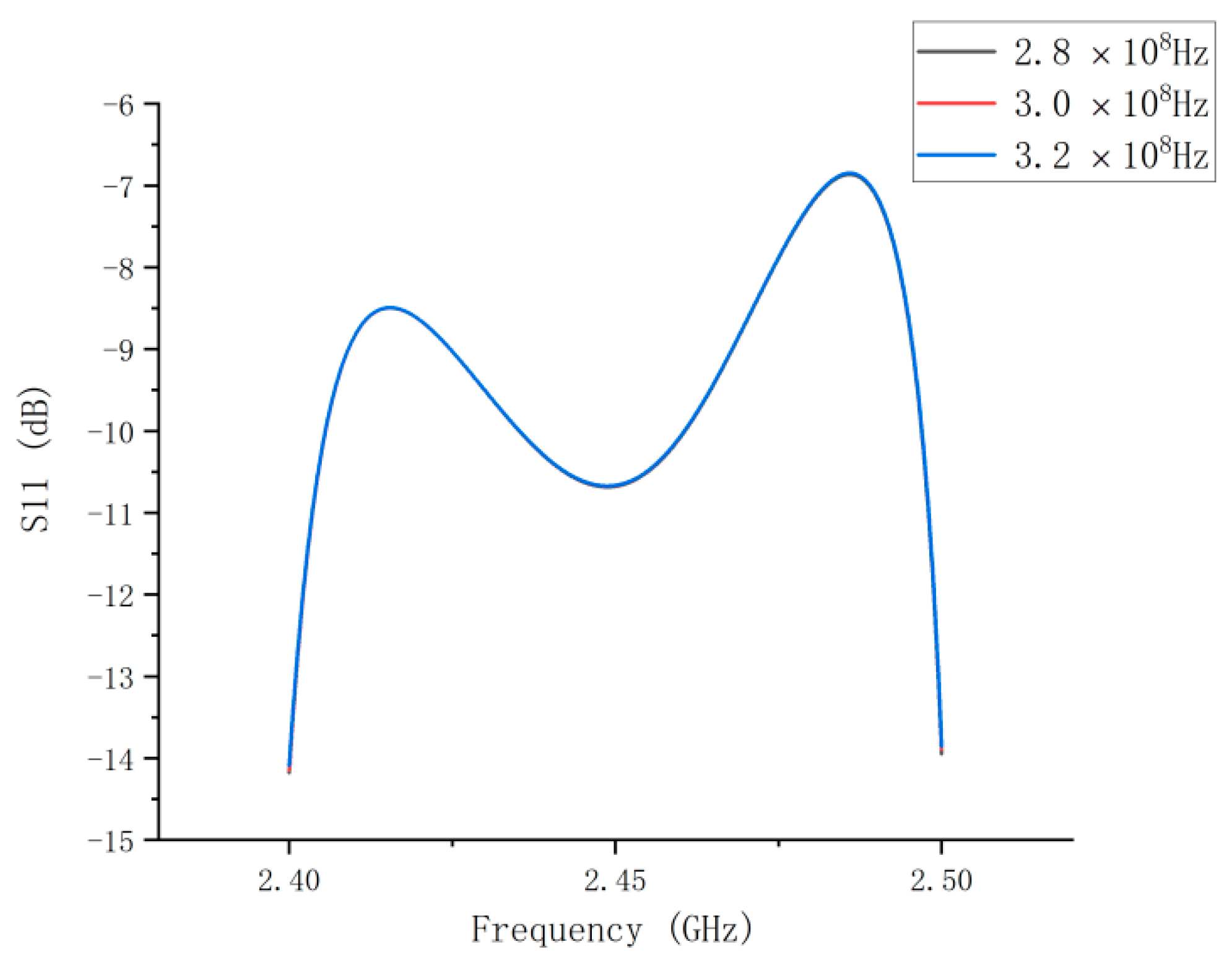

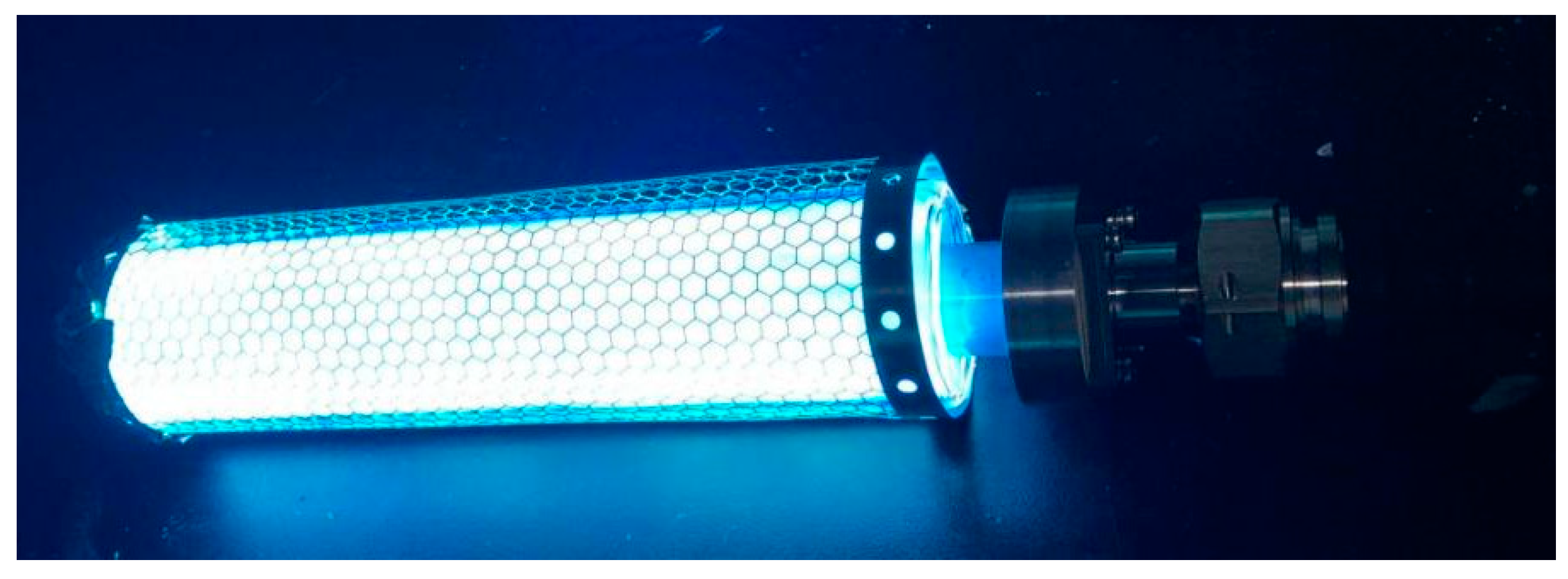

| Parameter | Value |
|---|---|
| Input power | 500 W |
| Microwave frequency | 2450 MHz |
| Plasma frequency | 3.4 × 1011 rad/s |
| Collision frequency | 3 × 108 Hz |
| Plasma breakdown field strength | 3.965 × 103 V/m |
| Plasma frequency maintained | 1.7 × 1011 rad/s |
| Parameter | Physical Meaning | Value |
|---|---|---|
| W_slot | Width of all slots | 16 mm |
| Phi | Central angle of all metal slots | 310° |
| Rin | Outer diameter of inner conductor of coaxial radiator | 8 mm |
| Rout | Inner diameter of outer conductor of coaxial radiator | 19 mm |
| l | Total length of coaxial radiator | 200 mm |
| Distance | Distance between adjacent slotted metal centers | 18 mm |
| Distance 1 | Distance from first slotted center to short-circuit surface | 15 mm |
| Dout | Outer diameter of outer conductor of coaxial radiator | 25 mm |
| Plasma Frequencies | Maximum | Average |
|---|---|---|
| 3.3 × 1011 rad/s | 121,850 V/m | 77,754 V/m |
| 3.4 × 1011 rad/s | 122,489 V/m | 77,980 V/m |
| 3.5 × 1011 rad/s | 122,109 V/m | 77,854 V/m |
| Plasma Collision Frequencies | Maximum | Average |
|---|---|---|
| 2.8 × 108 Hz | 122,050 V/m | 77,702 V/m |
| 3.0 × 108 Hz | 122,489 V/m | 77,980 V/m |
| 3.2 × 108 Hz | 122,195 V/m | 77,796 V/m |
| Distance | UV Lamp Power |
|---|---|
| 10 | |
| 15 | |
| 20 | |
| 25 | |
| 30 |
Publisher’s Note: MDPI stays neutral with regard to jurisdictional claims in published maps and institutional affiliations. |
© 2022 by the authors. Licensee MDPI, Basel, Switzerland. This article is an open access article distributed under the terms and conditions of the Creative Commons Attribution (CC BY) license (https://creativecommons.org/licenses/by/4.0/).
Share and Cite
Huang, Y.; Zhong, N.; Zhu, H.; Huang, K. Microwave-Driven Electrodeless Ultraviolet Lamp Based on Coaxial Slot Radiator. Processes 2022, 10, 890. https://doi.org/10.3390/pr10050890
Huang Y, Zhong N, Zhu H, Huang K. Microwave-Driven Electrodeless Ultraviolet Lamp Based on Coaxial Slot Radiator. Processes. 2022; 10(5):890. https://doi.org/10.3390/pr10050890
Chicago/Turabian StyleHuang, Yuqing, Nanya Zhong, Huacheng Zhu, and Kama Huang. 2022. "Microwave-Driven Electrodeless Ultraviolet Lamp Based on Coaxial Slot Radiator" Processes 10, no. 5: 890. https://doi.org/10.3390/pr10050890
APA StyleHuang, Y., Zhong, N., Zhu, H., & Huang, K. (2022). Microwave-Driven Electrodeless Ultraviolet Lamp Based on Coaxial Slot Radiator. Processes, 10(5), 890. https://doi.org/10.3390/pr10050890







